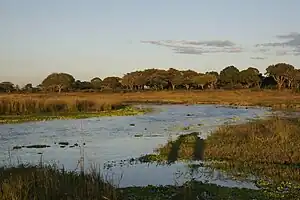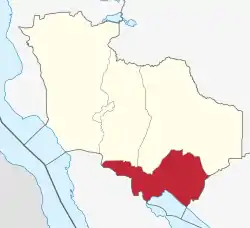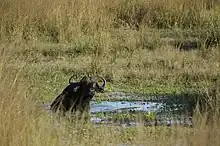Mpimbwe | |
|---|---|
 | |
 Mpimbwe District location in the Katavi Region | |
| Coordinates: 7°10′30″S 31°47′13″E / 7.175°S 31.787°E | |
| Country | |
| Region | Katavi Region |
| District | Mpimbwe District |
| Established[1]: 1 | 2016 |
| Government | |
| • Type | Council |
| • Chairman[2] | Silas R. Ilumba |
| • Director[2] | Catherine M. Mashalla |
| Area [1]: 1 | |
| • Total | 7,704.84 km2 (2,974.86 sq mi) |
| • Water | 39.44 km2 (15.23 sq mi) |
| Elevation [1]: 1 | 1,250 m (4,100 ft) |
| Population | |
| • Total | 117,934 |
| • Density | 15/km2 (40/sq mi) |
| Time zone | UTC+3 (EAT) |
| Postcode[4] | 50xxx |
| Area code | 025 |
| Website | District Website |
Mpimbwe District is a district council in the Katavi Region of Tanzania's Southern Highlands established in 2012. The district lies in the south of the region on Lake Rukwa.
History
The district was established in 2016 from the Mlele District Council. The Mlele District had been created 4 years prior from the Mpanda District Council in 2012. The same year, the Katavi Region was created by splitting off from the Rukwa Region which it had been a part of since its creation in 1974. Prior to 1974, and throughout colonization, it had been a part of the Tabora Region.[1]: 1 [5][6]
Geography
Mpimbwe District lies in the south of the Katavi Region with the Katavi districts of Nsimbo District in the north, and Mlele in the east. The Songwe District of the Songwe Region is the south-east. Rukwa Region's districts of Sumbawanga to the south along the shores Lake Rukwa with the Nkasi District to the south-east. The district covers an area of 7,704.84 square kilometres (2,974.86 sq mi).[7][1]: 1
Climate
The districts climate is tropical savanna climate with the Aw Koppen-Geiger system classification. The average temperature is 23.2 °C (73.8 °F) with an average rainfall of 828 millimetres (32.6 in).[8]
Administrative divisions
Mpimbwe has two division, 9 wards, and 31 villages and 168 hamlets.[9][1]: 2
Wards (2016 population)[3]: 174
- Chamalendi (8,747)
- Ikuba (9,084)
- Kasansa (9,025)
- Kibaoni (14,102)
- Majimoto (20,674)
- Mamba (24,520)
- Mbede (11,993)
- Mwamapuli (9,745)
- Usevya (10,042)
Demographics
In 2016 the Tanzania National Bureau of Statistics report there were 117,934 people in the district, from 103,165 in 2012. People of the district are mostly of the tribes of Wasukuma at 60%, and Wapimbwe at 20%. There are smaller populations of Wafipa, Wabende, Wangoni, Wachagga.[3]: 174 [1]: 3
The Wapimbwe are native to the area, while the Wasukuma started to settled the area in the 1970.[10][11]: 85 [12]: 1010
Economy
Small scale farming is the dominant economic activity with 95% of the population. Cassava, paddy and maize are the main crops grown for food, with groundnuts, paddy and maize being grown for cash. In 2016 there were 39,883 cattle, 30,235 goats, 8,206 sheep, 2,650 pigs, 80,600 imported chickens, and 236,232 native chickens.[1]: 4,24
Education
There are 29 primary schools in the districts teaching 20,308 students, of whom 10,049 are girls and 10,259 are boys. The district has 4 secondary schools teaching 1,612 of whom 638 are girls and 974 are boys. The district has 1 College (Mizengo Pinda Campus College-SUA), which provide Bachelor in Bee Resources Management, Diploma in Crop production and Certificate in Tourism and Hunting, college capacity holding more than 300 students [1]: 9-14
Health
The district has high food insecurity and illnesses. Msalala has 2 health centers and 10 clinics. In 2016, 42% of the rural population had safe and reliable clean water. The maternal morality ratio is 58/100,000 mothers, compared to the 3/100,000 national ratio.[13]: 703 [1]: 19,26-27
Wildlife

Some of the wild animals of the Mpimbwe District are elephants, lions, hippopotamus, hyena, buffalos, giraffes, and pigs. The Katavi National Park and Rukwa Game Reserve are located in, and adjacent, to the district.[1]: 23 [14]
There still exist conflicts with wildlife, but it is decreasing with very little livestock loss to lions or hyena today.[12]: 1008-1017 [11]
Roads
Masala District has no paved roads in 2016. It had 54.6 kilometres (33.9 mi) of gravel road, and 653.81 km2 (252.44 sq mi) of dirt road for a total road network of 708.41 km (440.19 mi). Of the road network, 205.2 km (127.5 mi) is usable all year.[1]: 98-108 [15]
References
- 1 2 3 4 5 6 7 8 9 10 11 12 Kiwale, Erasto N. (June 2016). "Mpimbwe District Council Strategic Plan" (PDF). mpimbwedc.go.tz. Mpimbwe District: Mpimbew District Council. Archived (PDF) from the original on 27 June 2022. Retrieved 11 September 2022.
- 1 2 "Halmashauri ya Wilaya ya Mpimbwe". mpimbwedc.go.tz (in Swahili). Mpimbwe: Mpimbwe District Council. Archived from the original on 11 July 2022. Retrieved 10 September 2022.
- 1 2 3 2016 Makadirio ya Idadi ya Watu katika Majimbo ya Uchaguzi kwa Mwaka 2016, Tanzania Bara [Population Estimates in Administrative Areas for the Year 2016, Mainland Tanzania] (PDF) (Report) (in Swahili). Dar es Salaam, Tanzania: National Bureau of Statistics. 1 April 2016. Archived (PDF) from the original on 27 December 2021. Retrieved 11 September 2022.
- ↑ "Katavi Postcodes" (PDF). Tanzania Communications Regulatory Authority. Archived (PDF) from the original on 29 July 2022. Retrieved 11 September 2022.
- ↑ "Mpango Mkakati". mleledc.go.tz (in Swahili). Mlele: Mlele District Council. Archived from the original on 18 June 2022. Retrieved 11 September 2022.
- ↑ "Historia". rukwa.go.tz (in Swahili). Rukwa: Rukwa Regional Council. Archived from the original on 15 June 2022. Retrieved 11 September 2022.
- ↑ "Tanzania Districts Shapefiles - 2019". nbs.go.tz (in English and Swahili). Dodoma, Tanzania: National Bureau of Statistics (Tanzania). Archived from the original on 9 September 2022. Retrieved 11 September 2022.
- ↑ "Climate Mapili (Tanzania)". climate-data.org (in English and German). Germany: Climate-data. Archived from the original on 11 September 2022. Retrieved 11 September 2022.
- ↑ "Takwimu". mpimbwedc.go.tz (in Swahili). Mpimbwe: Mpimbwe District Council. Archived from the original on 22 June 2022. Retrieved 11 September 2022.
- ↑ Seel, S.J.; Mgawe, P. (2014). The History and Traditions of the Pimbwe. Mkuki Na Nyota Publishers. ISBN 978-9987-08-286-5. Retrieved 11 September 2022.
- 1 2 Fitzherbert, E.; Caro, T.; Johnson, P. J.; Macdonald, D. W.; Borgerhoff Mulder, M. (1 June 2014). "From avengers to hunters: Leveraging collective action for the conservation of endangered lions" (PDF). Biological Conservation. 174: 84–92. doi:10.1016/j.biocon.2014.03.012. ISSN 0006-3207. S2CID 84105290.
- 1 2 Borgerhoff Mulder, Monique; Kwiyega, Jonathan L.; Beccaria, Simone; Bwasama, Sylvester S.; Fitzherbert, Emily; Genda, Peter; Caro, Tim (1 December 2019). "Lions, Bylaws, and Conservation Metrics". BioScience. Oxford University Press. 69 (12): 1008–1018. doi:10.1093/biosci/biz114. hdl:21.11116/0000-0005-1102-5. ISSN 0006-3568.
- ↑ Kasper, Claudia; Mulder, Monique B. (October 2015). "Who Helps and Why?: Cooperative Networks in Mpimbwe". Current Anthropology. 56 (5): 703. doi:10.1086/683024. ISSN 0011-3204. S2CID 147313220. Retrieved 11 September 2022.
the prevalence of food insecurity ... together with the vagaries of family labor where illness is so common
- ↑ "Katavi National Park". tanzaniaparks.go.tz (in English and Swahili). Dodoma, Tanzania: Tanzania National Parks Authority. Archived from the original on 7 July 2022. Retrieved 11 September 2022.
- ↑ "Katavi Region Roads Network" (PDF). tanroads.go.tz. Dodoma, Tanzania: TANROADS. Archived (PDF) from the original on 11 September 2022. Retrieved 11 September 2022.